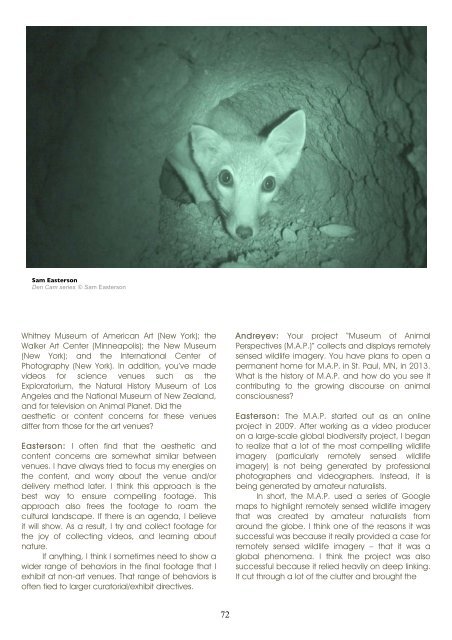Animal Influence I - Antennae The Journal of Nature in Visual Culture
Animal Influence I - Antennae The Journal of Nature in Visual Culture
Animal Influence I - Antennae The Journal of Nature in Visual Culture
You also want an ePaper? Increase the reach of your titles
YUMPU automatically turns print PDFs into web optimized ePapers that Google loves.
Sam Easterson<br />
Den Cam series Sam Easterson<br />
Whitney Museum <strong>of</strong> American Art (New York); the<br />
Walker Art Center (M<strong>in</strong>neapolis); the New Museum<br />
(New York); and the International Center <strong>of</strong><br />
Photography (New York). In addition, you’ve made<br />
videos for science venues such as the<br />
Exploratorium, the Natural History Museum <strong>of</strong> Los<br />
Angeles and the National Museum <strong>of</strong> New Zealand,<br />
and for television on <strong>Animal</strong> Planet. Did the<br />
aesthetic or content concerns for these venues<br />
differ from those for the art venues?<br />
Easterson: I <strong>of</strong>ten f<strong>in</strong>d that the aesthetic and<br />
content concerns are somewhat similar between<br />
venues. I have always tried to focus my energies on<br />
the content, and worry about the venue and/or<br />
delivery method later. I th<strong>in</strong>k this approach is the<br />
best way to ensure compell<strong>in</strong>g footage. This<br />
approach also frees the footage to roam the<br />
cultural landscape. If there is an agenda, I believe<br />
it will show. As a result, I try and collect footage for<br />
the joy <strong>of</strong> collect<strong>in</strong>g videos, and learn<strong>in</strong>g about<br />
nature.<br />
If anyth<strong>in</strong>g, I th<strong>in</strong>k I sometimes need to show a<br />
wider range <strong>of</strong> behaviors <strong>in</strong> the f<strong>in</strong>al footage that I<br />
exhibit at non-art venues. That range <strong>of</strong> behaviors is<br />
<strong>of</strong>ten tied to larger curatorial/exhibit directives.<br />
72<br />
Andreyev: Your project “Museum <strong>of</strong> <strong>Animal</strong><br />
Perspectives (M.A.P.)” collects and displays remotely<br />
sensed wildlife imagery. You have plans to open a<br />
permanent home for M.A.P. <strong>in</strong> St. Paul, MN, <strong>in</strong> 2013.<br />
What is the history <strong>of</strong> M.A.P. and how do you see it<br />
contribut<strong>in</strong>g to the grow<strong>in</strong>g discourse on animal<br />
consciousness?<br />
Easterson: <strong>The</strong> M.A.P. started out as an onl<strong>in</strong>e<br />
project <strong>in</strong> 2009. After work<strong>in</strong>g as a video producer<br />
on a large-scale global biodiversity project, I began<br />
to realize that a lot <strong>of</strong> the most compell<strong>in</strong>g wildlife<br />
imagery (particularly remotely sensed wildlife<br />
imagery) is not be<strong>in</strong>g generated by pr<strong>of</strong>essional<br />
photographers and videographers. Instead, it is<br />
be<strong>in</strong>g generated by amateur naturalists.<br />
In short, the M.A.P. used a series <strong>of</strong> Google<br />
maps to highlight remotely sensed wildlife imagery<br />
that was created by amateur naturalists from<br />
around the globe. I th<strong>in</strong>k one <strong>of</strong> the reasons it was<br />
successful was because it really provided a case for<br />
remotely sensed wildlife imagery – that it was a<br />
global phenomena. I th<strong>in</strong>k the project was also<br />
successful because it relied heavily on deep l<strong>in</strong>k<strong>in</strong>g.<br />
It cut through a lot <strong>of</strong> the clutter and brought the












